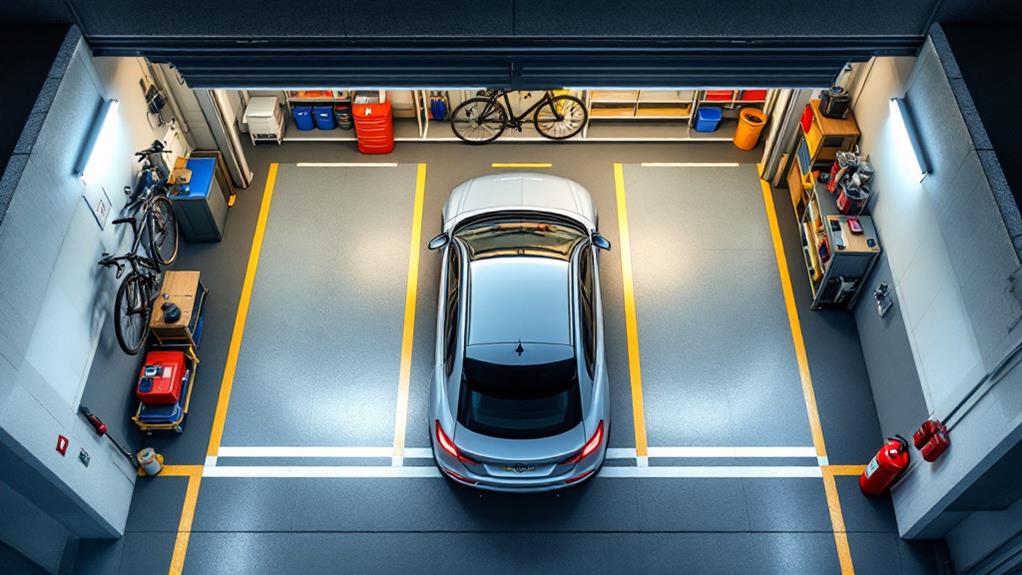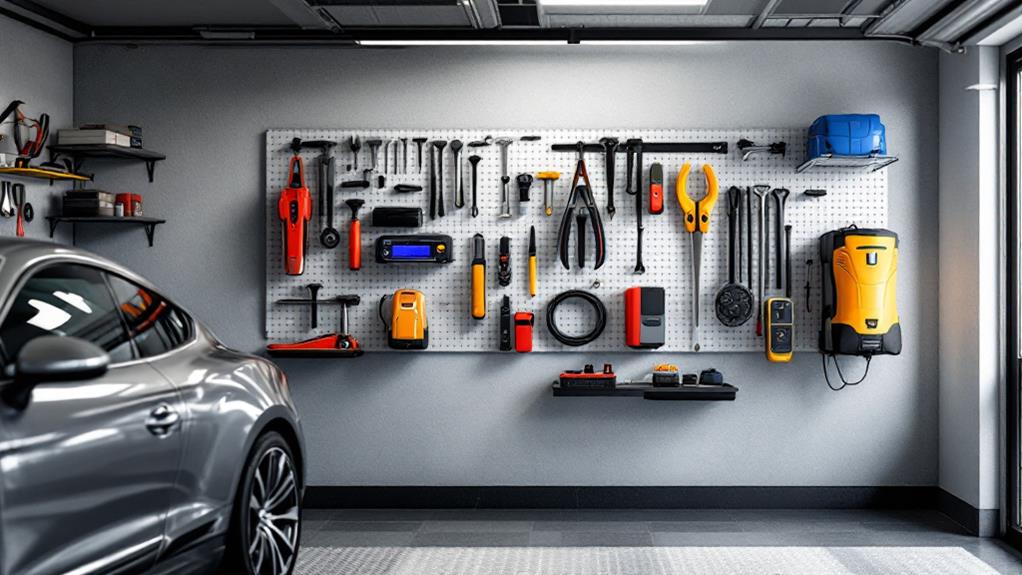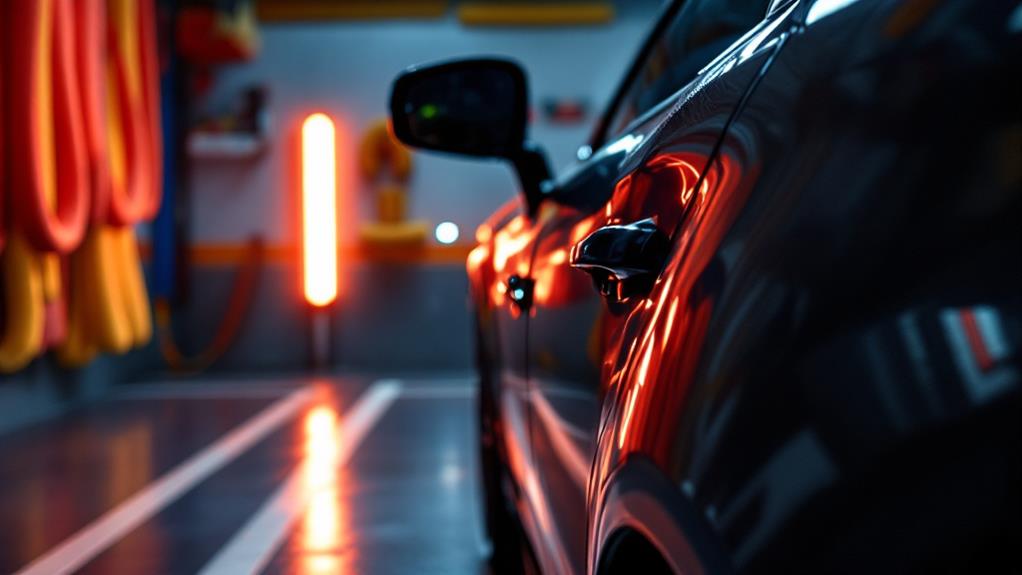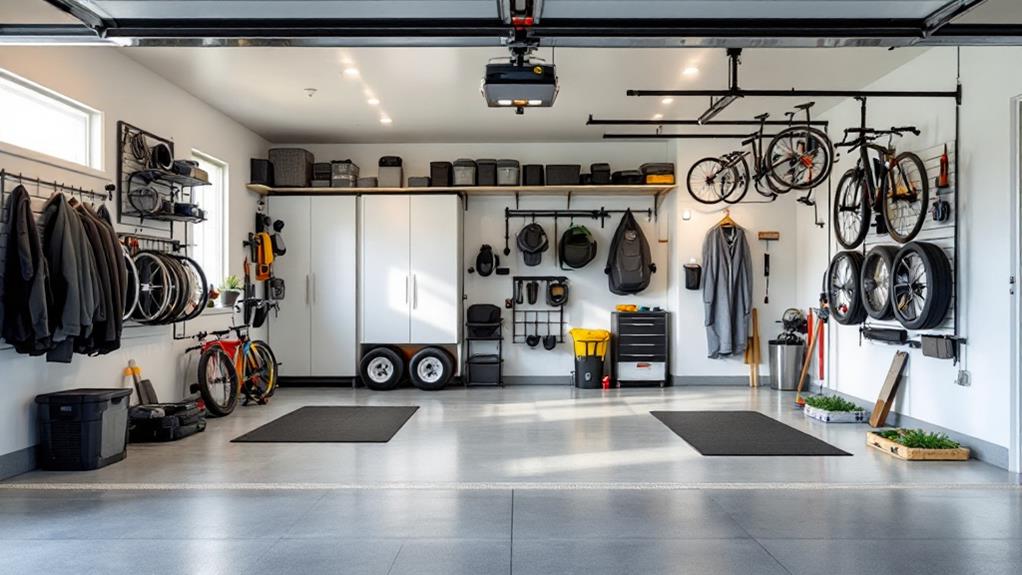Tips for Parking Large Vehicles in a Standard Home Garage
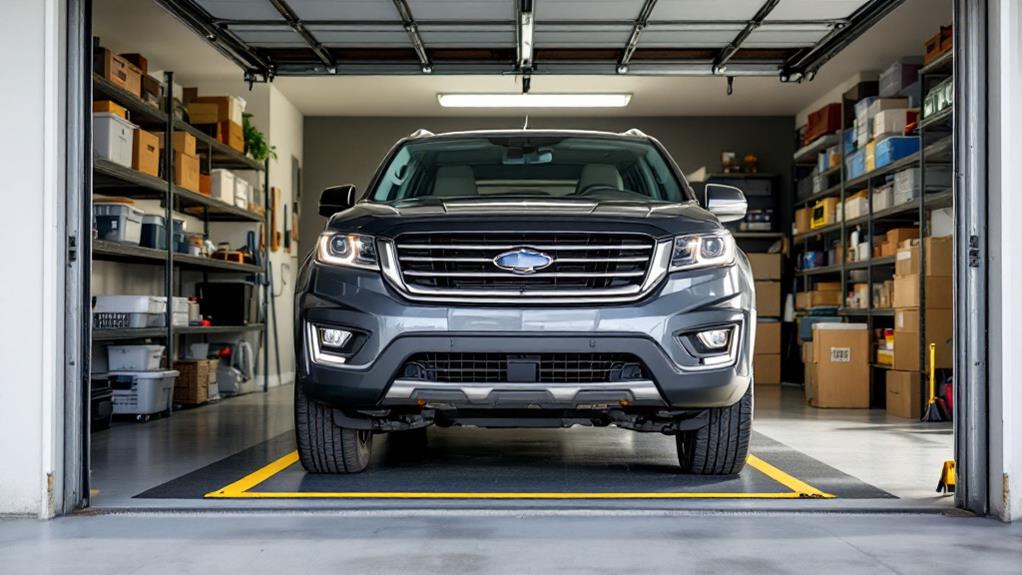
To park large vehicles in a standard home garage, start by measuring both your garage and vehicle to guarantee a proper fit. Clear out unnecessary clutter to maximize space, and install parking aids like bumper blocks or sensors. Create visual guides with floor markings or hanging tennis balls to help with positioning. Optimize your garage door opening space and use mirrors for better visibility. Enhance lighting to improve safety and ease of maneuvering. Practice your parking techniques regularly, and consider lift or ramp options for increased capacity. With these tips, you'll be able to tackle even the tightest parking situations. Uncover more ways to make your garage work for you below.
Measure Your Garage and Vehicle
Garage measurements are crucial when it comes to parking large vehicles in a standard home garage. To guarantee your car garage can accommodate your oversized vehicle, you'll need to take precise measurements of both your garage space and your vehicle.
Start by measuring the width, depth, and height of your garage. Pay close attention to any obstructions like support beams or utility pipes that might limit the available space. Next, determine the exact dimensions of your vehicle, including any attachments or add-ons. Remember to account for opened doors and mirrors when measuring width.
Compare these measurements to verify that your garage size provides enough room for your vehicle. You'll want to guarantee there's sufficient clearance on all sides for easy maneuvering and access. A typical two-car garage is about 20 feet wide and 20 feet deep, but your garage may vary.
Don't forget to ponder your vehicle's weight and ensure your garage floor can support it without risk of damage. If your garage is at least 22 feet deep and 12 feet wide, you should have enough space for most large vehicles. However, always double-check to avoid any surprises when attempting to park.
Clear Unnecessary Clutter
Once you've confirmed that your garage can accommodate your large vehicle, it's time to tackle the clutter. Start by removing any unnecessary items from your garage to create more space for maneuvering. This additional room will be essential when parking your sizeable vehicle.
To maximize your garage's storage potential, utilize wall-mounted solutions and overhead racks. These options free up valuable floor space, giving you more room to maneuver. Next, go through your belongings and decide what to keep, donate, sell, or dispose of properly. This process will help you eliminate unused or unwanted items that are taking up precious space.
Organize your remaining tools, equipment, and supplies into designated areas. This step will optimize the available space and make it easier to find what you need when working on your vehicle. Remember to regularly purge and declutter your garage to maintain ample room for parking. By keeping on top of organization, you'll ensure that your garage remains spacious enough for your large vehicle.
Install Parking Aids
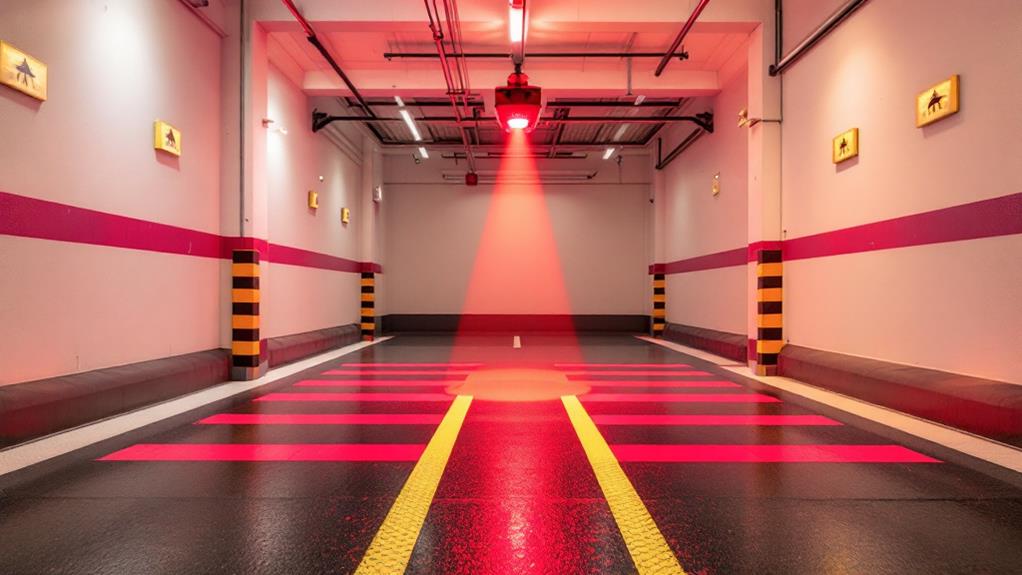
Along with clearing clutter, installing parking aids can greatly improve your ability to maneuver large vehicles in your garage. Consider adding bumper blocks or parking sensors to guide your vehicle safely into position and prevent collisions with walls or other objects. These aids provide visual or auditory cues, helping you park with precision.
Invest in a garage door opener with remote access for easier entry and exit. This feature allows you to open and close the door from inside your vehicle, reducing the risk of accidents while maneuvering. Additionally, a garage door tilt sensor can automatically stop the door if it detects an obstruction, protecting both your vehicle and the door itself from damage.
Maximize your garage's efficiency by designating specific parking spots for each large vehicle. This organization helps optimize available space and guarantee everyone knows where to park. Establish clear parking protocols with all household members to maintain a safe and efficient parking process. Communicate these guidelines effectively to prevent confusion and potential accidents.
Create Visual Guides
Visual aids can alter your parking experience when maneuvering large vehicles in a standard garage. Creating visual guides helps you navigate tight spaces and position your vehicle accurately. Start by marking the garage floor with brightly colored tape or paint, indicating where your tires should align when parking. Ensure these lines are wide enough to be easily visible from your driver's seat.
Next, install vertical guides along the sides of your parking space. Use foam pool noodles or PVC pipes attached to the walls to create soft bumpers that won't damage your vehicle if touched. Place a tennis ball on a string, hanging from the ceiling, to mark the perfect stopping point for your front bumper. This simple visual guide prevents you from pulling in too far.
Consider adding reflective strips to your garage door frame, making it easier to judge the width of the opening when entering. If your garage isn't quite wide enough, a car lift can maximize vertical space, allowing you to park one vehicle above another. Remember, well-placed visual guides can substantially reduce the stress of parking large vehicles in tight spaces.
Optimize Door Opening Space
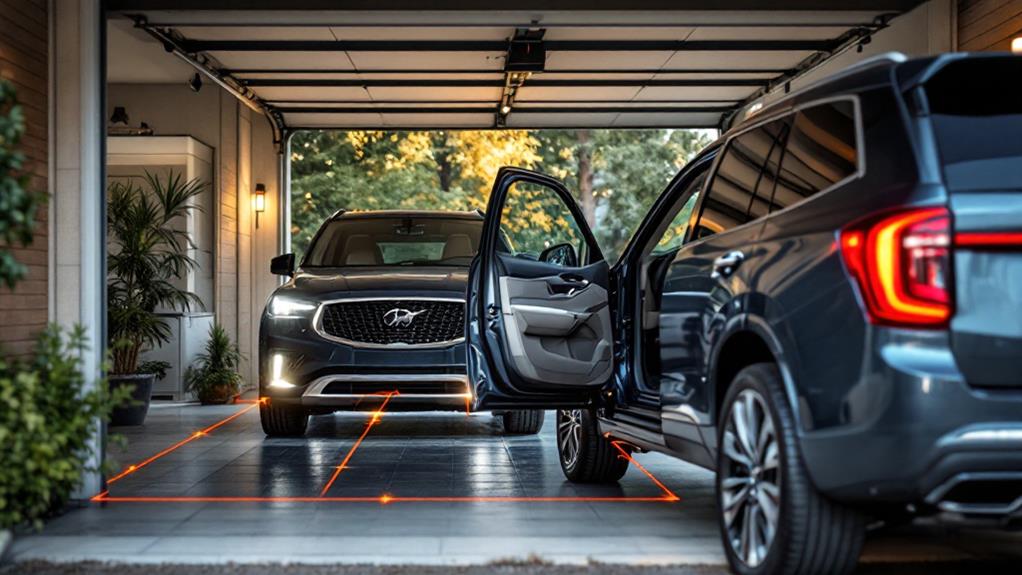
Optimizing door opening space is crucial when parking large vehicles in a standard home garage. To guarantee your car can enter and exit safely, you'll need to consider the size of your garage doors. It's recommended that the opening be at least 2-3 feet wider than your largest vehicle. This extra space allows for comfortable maneuvering without risking damage to your car or the doors.
If you're dealing with particularly large vehicles, contemplate installing extra-wide garage doors. These typically range from 14 to 16 feet in width, providing ample clearance for even the biggest cars or trucks. When planning your garage layout, don't forget to account for your vehicle's turning radius. This will help you determine if you have enough space to park and retrieve your car easily.
For those with limited space, innovative solutions like angled parking or a turntable system can make a significant difference. These options can simplify the process of getting your vehicle in and out of the garage. Additionally, installing a garage door opener with remote control or smartphone integration can make accessing your garage more convenient, especially when dealing with larger vehicles that require precise positioning.
Consider Angled Parking
When space is at a premium in your standard home garage, angled parking can be a transformative solution for accommodating larger vehicles. By positioning your cars at a 45-60 degree angle, you can maximize the available space and fit vehicles up to 20 feet long in a garage as small as 22 x 24 feet. This technique works particularly well for sedans, SUVs, and smaller trucks, allowing you to accommodate two cars more comfortably.
Angled parking reduces the overall space needed for each vehicle by minimizing side clearance and front/rear space requirements. This configuration can be especially helpful if you have a foot door that limits your maneuvering room. However, keep in mind that while angled parking offers benefits, it may also limit your flexibility to rearrange vehicle positions within your Home Garage.
When implementing this strategy, you'll need to be more careful when entering and exiting the garage. The tighter fit means you'll have less room for error, but with practice, you'll find it easier to manage. Remember that very large vehicles may still struggle to fit, so consider your specific car size before committing to this arrangement.
Use Mirrors for Visibility
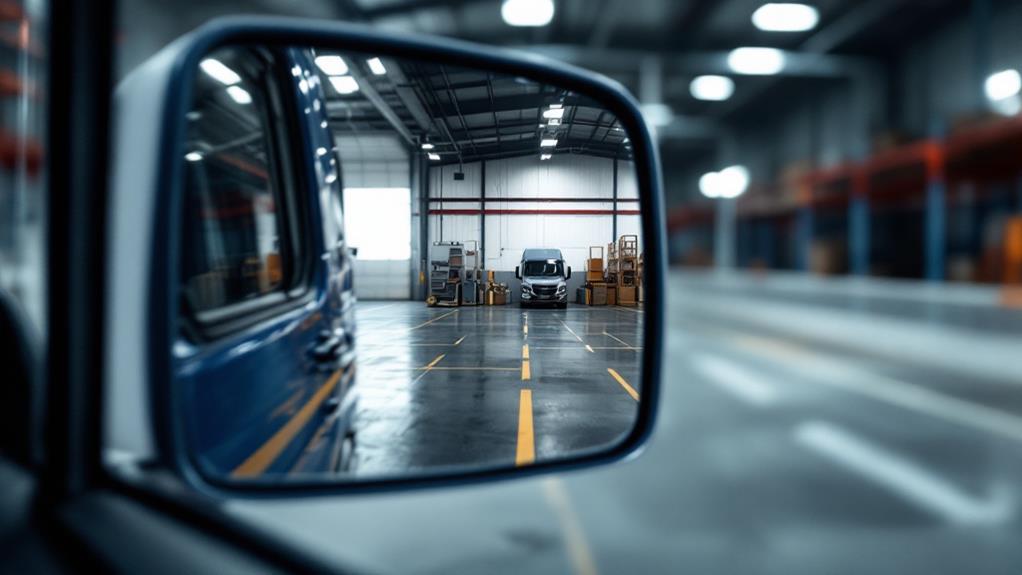
Improving visibility is key to safely parking large vehicles in a standard home garage. As a vehicle owner, you can significantly enhance your parking experience by strategically placing mirrors throughout your garage. Install large, adjustable mirrors on the walls to help you see blind spots and maneuver more easily in your parking area.
Position these mirrors at ideal angles to provide clear views of the entire garage space, including areas that might be obstructed by your vehicle's size. For a wide garage or one that's several feet high, consider using convex mirrors to expand your field of view. These curved mirrors can help you judge distances more accurately when parking large vehicles, giving you a better sense of how much room you have to work with.
Ensure that the mirrors you install are securely mounted to withstand vibrations and movements as you park. For added safety in low-light conditions, consider adding LED lighting around the mirrors. This combination of mirrors and lighting can alter a challenging parking situation into a much more manageable task, even if you don't have a particularly wide x deep garage space.
Enhance Garage Lighting
Proper illumination can make a world of difference when parking large vehicles in a standard home garage. To enhance your garage lighting, start by installing bright, energy-efficient LED lights on the garage ceiling. These will considerably improve visibility and safety, making it easier to maneuver your large vehicle in the limited extra space.
Consider using motion-activated lights that automatically illuminate when you enter the garage or open the garage doors. This feature is especially helpful when you're returning home at night. To maximize the effectiveness of your lighting, apply a reflective coating to your garage floor. This will create a brighter environment and help you see any obstacles more clearly.
Don't forget to illuminate all areas of your working garage, including corners and alcoves, to eliminate dark spots that could hinder your parking efforts. For added flexibility, install dimmable lighting controls. This allows you to adjust the brightness based on your needs, whether you're parking your vehicle or working on a project. With these lighting improvements, your garage will feel more like a well-lit parking lot, making it easier to park large vehicles with confidence.
Practice Maneuvering Techniques
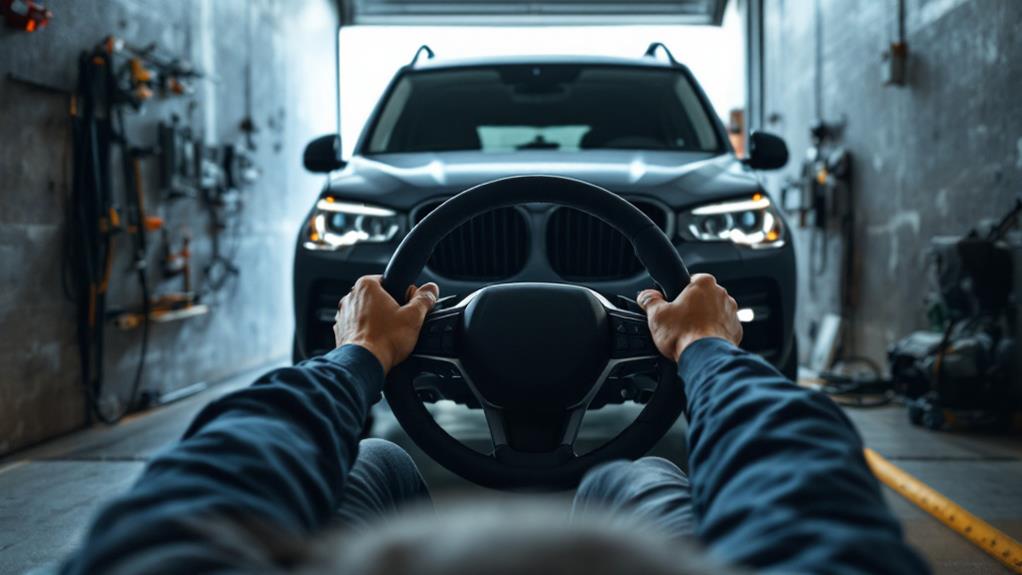
Commanding three key maneuvering techniques can greatly improve your ability to park large vehicles in a standard home garage. To maximize your place to park and guarantee room to walk around, practice these essential skills:
- Reverse slowly and precisely: Use turn signals, side mirrors, and a rearview camera to guide you. This technique helps you avoid collisions and leaves extra storage space.
- Execute tight turns: Drive at a slight angle and straighten out once centered. This method allows you to navigate even the minimum size garage with ease.
- Leverage power steering: Take advantage of this feature to maneuver in tight spaces. Go slow and make small adjustments for better control.
- Perform practice runs: Familiarize yourself with your garage's dimensions and identify potential trouble spots.
Explore Lift or Ramp Options
Several innovative lift and ramp options can alter your garage's parking capacity, making it easier to accommodate large vehicles. Consider installing a car lift, which can double your parking space by elevating one vehicle above another. This solution is ideal if you have high ceilings and need to maximize vertical space.
Retractable car ramps offer another space-saving option. When you're not using your vehicle, you can raise it off the ground, creating extra room for storage or movement. Motorized car stackers take this concept further by vertically stacking multiple vehicles, greatly increasing your garage's capacity.
If maneuvering is your main concern, vehicle turntables can be a transformative solution. They allow you to easily rotate larger cars, simplifying entry and exit in tight spaces. For those with seldom-used vehicles, folding or sliding ramps provide access to raised storage platforms, keeping your main parking area clear.
Before implementing any of these solutions, verify that your garage doors would accommodate the added height or width. Measure carefully and consult professionals to determine the best option for your specific needs and garage configuration.
